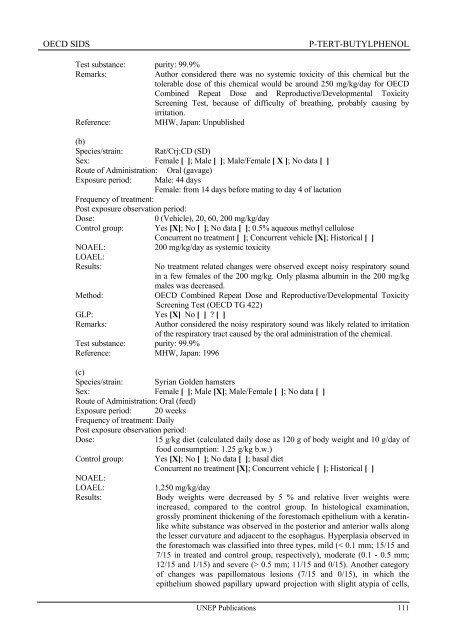p-Tert-Butylphenol - UNEP Chemicals
p-Tert-Butylphenol - UNEP Chemicals
p-Tert-Butylphenol - UNEP Chemicals
Create successful ePaper yourself
Turn your PDF publications into a flip-book with our unique Google optimized e-Paper software.
OECD SIDS P-TERT-BUTYLPHENOL<br />
Test substance: purity: 99.9%<br />
Remarks: Author considered there was no systemic toxicity of this chemical but the<br />
tolerable dose of this chemical would be around 250 mg/kg/day for OECD<br />
Combined Repeat Dose and Reproductive/Developmental Toxicity<br />
Screening Test, because of difficulty of breathing, probably causing by<br />
irritation.<br />
Reference: MHW, Japan: Unpublished<br />
(b)<br />
Species/strain: Rat/Crj:CD (SD)<br />
Sex: Female [ ]; Male [ ]; Male/Female [ X ]; No data [ ]<br />
Route of Administration: Oral (gavage)<br />
Exposure period: Male: 44 days<br />
Female: from 14 days before mating to day 4 of lactation<br />
Frequency of treatment:<br />
Post exposure observation period:<br />
Dose: 0 (Vehicle), 20, 60, 200 mg/kg/day<br />
Control group: Yes [X]; No [ ]; No data [ ]; 0.5% aqueous methyl cellulose<br />
Concurrent no treatment [ ]; Concurrent vehicle [X]; Historical [ ]<br />
NOAEL: 200 mg/kg/day as systemic toxicity<br />
LOAEL:<br />
Results: No treatment related changes were observed except noisy respiratory sound<br />
in a few females of the 200 mg/kg. Only plasma albumin in the 200 mg/kg<br />
males was decreased.<br />
Method: OECD Combined Repeat Dose and Reproductive/Developmental Toxicity<br />
Screening Test (OECD TG 422)<br />
GLP: Yes [X] No [ ] ? [ ]<br />
Remarks: Author considered the noisy respiratory sound was likely related to irritation<br />
of the respiratory tract caused by the oral administration of the chemical.<br />
Test substance: purity: 99.9%<br />
Reference: MHW, Japan: 1996<br />
(c)<br />
Species/strain: Syrian Golden hamsters<br />
Sex: Female [ ]; Male [X]; Male/Female [ ]; No data [ ]<br />
Route of Administration: Oral (feed)<br />
Exposure period: 20 weeks<br />
Frequency of treatment: Daily<br />
Post exposure observation period:<br />
Dose: 15 g/kg diet (calculated daily dose as 120 g of body weight and 10 g/day of<br />
food consumption: 1.25 g/kg b.w.)<br />
Control group: Yes [X]; No [ ]; No data [ ]; basal diet<br />
Concurrent no treatment [X]; Concurrent vehicle [ ]; Historical [ ]<br />
NOAEL:<br />
LOAEL: 1,250 mg/kg/day<br />
Results: Body weights were decreased by 5 % and relative liver weights were<br />
increased, compared to the control group. In histological examination,<br />
grossly prominent thickening of the forestomach epithelium with a keratinlike<br />
white substance was observed in the posterior and anterior walls along<br />
the lesser curvature and adjacent to the esophagus. Hyperplasia observed in<br />
the forestomach was classified into three types, mild (< 0.1 mm; 15/15 and<br />
7/15 in treated and control group, respectively), moderate (0.1 - 0.5 mm;<br />
12/15 and 1/15) and severe (> 0.5 mm; 11/15 and 0/15). Another category<br />
of changes was papillomatous lesions (7/15 and 0/15), in which the<br />
epithelium showed papillary upward projection with slight atypia of cells,<br />
<strong>UNEP</strong> Publications 111
















